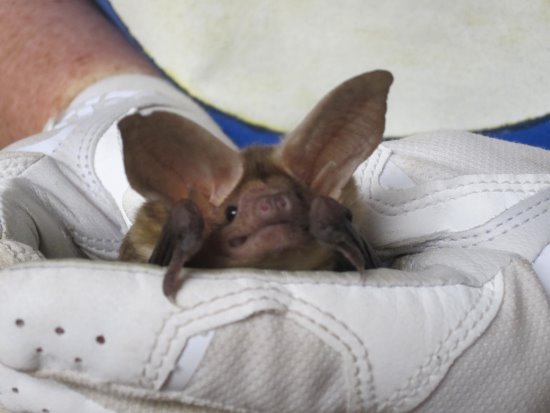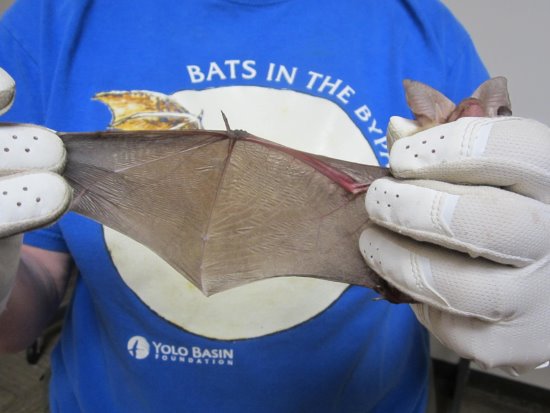 | | | A Pallid Bat up close and personal Photo Vera Kochan | | | | | | Although the Moraga Library doesn't have a belfry, there were plenty of bats on hand anyway during their May 16 "Bats at the Library!" presentation. The program was geared towards kids between ages 6 - 12 years; however, a handful of adults with an interest in the small, hairy mammals were also in attendance.
 Corky Quirk, a representative from Northern California Bats (NorCalBats), brought four different species from the organization's Sacramento Valley location. "NorCalBats is dedicated to the rescue, rehabilitation, and release of bats throughout Northern California," stated their website. "In addition, we are committed to public education regarding the environmental benefits of bats, and dispelling fears and myths that lead to the death of roosts and colonies. Trained volunteers care for injured and orphaned bats throughout the valley and surrounding foothills."
Corky Quirk, a representative from Northern California Bats (NorCalBats), brought four different species from the organization's Sacramento Valley location. "NorCalBats is dedicated to the rescue, rehabilitation, and release of bats throughout Northern California," stated their website. "In addition, we are committed to public education regarding the environmental benefits of bats, and dispelling fears and myths that lead to the death of roosts and colonies. Trained volunteers care for injured and orphaned bats throughout the valley and surrounding foothills."
 Many in the audience expected the bats to be much larger, but that misconception can be attributed to watching too many vampire movies where Dracula turns into his alter ego and flies off into the night. Instead, the average bat can be held in one hand, and those that Quirk brought were fully grown. For the bats' safety, audience members were not allowed to touch the critters as she brought them out of their enclosures one at a time to give everyone an up-close look.
Many in the audience expected the bats to be much larger, but that misconception can be attributed to watching too many vampire movies where Dracula turns into his alter ego and flies off into the night. Instead, the average bat can be held in one hand, and those that Quirk brought were fully grown. For the bats' safety, audience members were not allowed to touch the critters as she brought them out of their enclosures one at a time to give everyone an up-close look.
 Quirk's specimens included Big Brown Bats, Mexican Free-Tailed Bats, a Hoary Bat, and a Pallid Bat, which was recently named California's State Bat thanks to Senate Bill 732 signed by Governor Gavin Newsom.
Quirk's specimens included Big Brown Bats, Mexican Free-Tailed Bats, a Hoary Bat, and a Pallid Bat, which was recently named California's State Bat thanks to Senate Bill 732 signed by Governor Gavin Newsom.
 Some of the fun facts that attendees learned about bats during the presentation were that bats fly with their hands; worldwide there are over 1,400 species of bats (47 of which are in the United States, 26 of those are located in California, and 17 are found in our region); for the most part, bats eat insects, but some eat fruit, nectar, or very rarely meat; bats drink milk when they are born and water when they get older.
Some of the fun facts that attendees learned about bats during the presentation were that bats fly with their hands; worldwide there are over 1,400 species of bats (47 of which are in the United States, 26 of those are located in California, and 17 are found in our region); for the most part, bats eat insects, but some eat fruit, nectar, or very rarely meat; bats drink milk when they are born and water when they get older.
 More interesting facts are that bats can be found on every continent but Antarctica. They are born as a single birth, but there are rare occasions when they have a twin. Bat guano (droppings) is highly valued and used in fertilizers. A bat's wings are made of skin with trails of blood vessels within. If a wing is torn, thanks to the blood vessels, it can grow back and heal. House cats are a bat's primary predator, because they can climb trees. Raccoons and squirrels are also their enemies, in addition to any tree snakes.
More interesting facts are that bats can be found on every continent but Antarctica. They are born as a single birth, but there are rare occasions when they have a twin. Bat guano (droppings) is highly valued and used in fertilizers. A bat's wings are made of skin with trails of blood vessels within. If a wing is torn, thanks to the blood vessels, it can grow back and heal. House cats are a bat's primary predator, because they can climb trees. Raccoons and squirrels are also their enemies, in addition to any tree snakes.
 Depending on the species, bats can, on average, fly 100 mph, so this comes in handy when chasing their favored meal of flying insects, which they eat immediately. Because bats dine on insects that can be harmful to crops, the farming community appreciates them as a non-toxic and natural form of "pesticide".
Depending on the species, bats can, on average, fly 100 mph, so this comes in handy when chasing their favored meal of flying insects, which they eat immediately. Because bats dine on insects that can be harmful to crops, the farming community appreciates them as a non-toxic and natural form of "pesticide".
 Quirk informed everyone that, contrary to popular belief, bats are not blind. They navigate using echolocation by producing sound waves at frequencies above human hearing, called ultrasound. The sound waves they emit bounce off objects in their environment which then return to the bats' ears. Dogs and cats can hear the echolocation of bats.
Quirk informed everyone that, contrary to popular belief, bats are not blind. They navigate using echolocation by producing sound waves at frequencies above human hearing, called ultrasound. The sound waves they emit bounce off objects in their environment which then return to the bats' ears. Dogs and cats can hear the echolocation of bats.
 Bats do like to sleep during the day and hunt for food at night. They sleep upside-down by hanging onto objects with their sharp claws.
Bats do like to sleep during the day and hunt for food at night. They sleep upside-down by hanging onto objects with their sharp claws.
 According to Quirk, Hoary Bats are a large, hairy species that likes to stay in trees instead of hiding in caves. They arrive during the spring and fall and are considered to be solitary creatures. Mexican Free-Tailed Bats have short hair and very sharp teeth, and use their ears to help them fly. The Big Brown Bat can be found near wood such as dead trees, under the eaves of houses, and in barns. They chew their food and love to eat mealworms. Lastly, Pallid Bats can live in a variety of habitats. They have large ears and they hunt for food on the ground, looking for crickets, beetles, grasshoppers, and potato bugs. They've been known to enjoy munching on centipedes and scorpions without getting sick from the venom. They protect themselves by emitting a mild, skunk-like odor.
According to Quirk, Hoary Bats are a large, hairy species that likes to stay in trees instead of hiding in caves. They arrive during the spring and fall and are considered to be solitary creatures. Mexican Free-Tailed Bats have short hair and very sharp teeth, and use their ears to help them fly. The Big Brown Bat can be found near wood such as dead trees, under the eaves of houses, and in barns. They chew their food and love to eat mealworms. Lastly, Pallid Bats can live in a variety of habitats. They have large ears and they hunt for food on the ground, looking for crickets, beetles, grasshoppers, and potato bugs. They've been known to enjoy munching on centipedes and scorpions without getting sick from the venom. They protect themselves by emitting a mild, skunk-like odor.
 A bat on the ground is usually sick, injured, or orphaned. "Do not touch it," explained Quirk. "If you pick it up it will be scared and might fight back. There is a possibility of being bitten and contracting rabies . Instead, cover it with a box or container and call wildlife rescue."
A bat on the ground is usually sick, injured, or orphaned. "Do not touch it," explained Quirk. "If you pick it up it will be scared and might fight back. There is a possibility of being bitten and contracting rabies . Instead, cover it with a box or container and call wildlife rescue."
 For more information visit: norcalbats.org.
For more information visit: norcalbats.org. |

